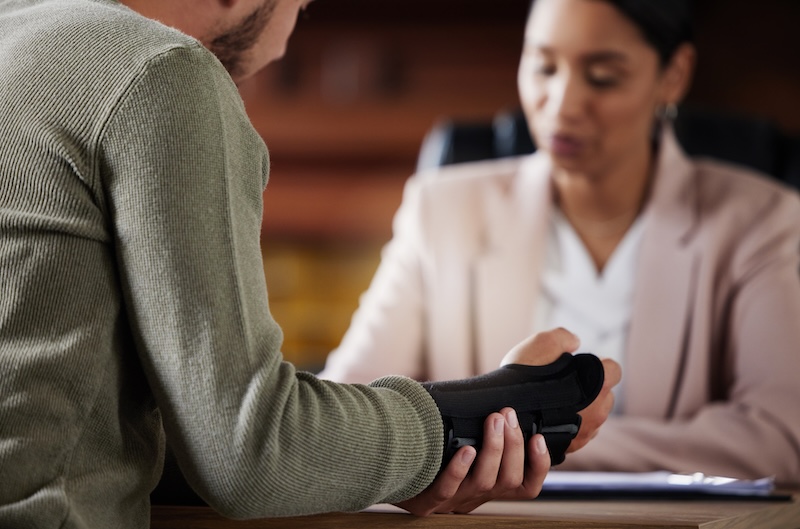KEY TAKEAWAYS
- Pedestrians in Virginia have the right of way in both marked and unmarked crosswalks.
- Pedestrians must use crosswalks and sidewalks when they are available.
- Pedestrians must obey traffic lights and walk/don’t walk signals.
- Under the state’s contributory negligence law, pedestrians may be barred from collecting compensation if their failure to obey Virginia crosswalk laws gave rise to the accident.
Your Responsibility as a Pedestrian Using Sidewalks
Under Virginia law, pedestrians must use sidewalks when they are available. When there is no sidewalk or shoulder on the road, pedestrians can walk on the extreme left edge of the road, facing oncoming traffic. Alternatively, they may use either shoulder if it is wide enough to permit safe walking.
Pedestrians can also leave sidewalks that are not reasonably suitable or passable. For example, the exception may apply if construction blocks their normal walking path. In these cases, they must follow the same rules as when there is no sidewalk.
To catch a bus, pedestrians can leave the sidewalk but cannot wait on the road longer than necessary. Virginia prohibits hitchhiking, so leaving a sidewalk or entering a road for that purpose can undermine your claim for compensation in the event of an accident.
In general, it is always best to avoid walking along roads without sidewalks unless absolutely necessary, especially in highly trafficked areas. Where possible, plan your route along roadways with designated walking paths.
Video Transcript
Jim Hurley:
“If you’re a pedestrian, it’s unbelievably important to go ahead and follow the laws in Virginia. So generally speaking, if there’s a traffic light, then that would control. So you wanna pay attention to the traffic light, and then when it indicates that you can walk, you wanna stay in the crosswalk. If there’s no traffic light, oftentimes intersections will have crosswalks. Oftentimes, there are crosswalks, even in non-intersection areas, so you always wanna cross at the crosswalk. That’s the basic rule in Virginia. And then obviously, when you’re crossing into a street, you wanna look both ways just to be sure there’s no oncoming traffic that could possibly hit you.”
Right-of-Way Rules for Crosswalks and Intersections
Under Virginia crosswalk laws, pedestrians have the right of way in marked and unmarked crosswalks and must use them when available. They must also obey traffic lights and pedestrian signals. Drivers and pedestrians alike have a legal duty to obey right-of-way laws in Virginia.
Pedestrians are also prohibited from darting out suddenly into the street, as doing so can lead to serious accidents when drivers slam their brakes to avoid hitting them. Virginia highway crossing laws prohibit pedestrians from “carelessly or maliciously” interfering with the orderly passage of vehicles.
If there is no crosswalk at an intersection, pedestrians should cross using the most direct route. This rules out crossing diagonally, which is otherwise only permitted at a crosswalk clearly marked for that purpose. Be careful when crossing a road without a marked crosswalk.
Do Pedestrians Always Have the Right Of Way?
Under Virginia law, drivers must yield to pedestrians at marked or unmarked crosswalks, regular intersections, and intersections on roads where the maximum speed limit is 35 miles per hour or lower. Drivers must also yield if a traffic control device or a law enforcement officer directs them to do so. To enhance pedestrian safety, vehicles coming from all four directions must stop at non-functioning traffic lights.
While Virginia traffic laws favor pedestrians in many situations, they do not always give them the right of way. For example, pedestrians must yield when there is no intersection. They must also avoid stepping into moving traffic where drivers can’t see them. Failure to yield as a pedestrian makes it extremely difficult to collect damages in the event of an accident, even when the driver was more at fault.
Safety Precautions for Pedestrians
There are many other common-sense precautions you can take to avoid pedestrian accidents. For example:
- Avoid distractions when walking, paying attention to traffic, road conditions, and potential hazards.
- Don’t simply assume that drivers see you—try to make contact or find other ways of confirming.
- Do not dart out suddenly into the street without giving drivers time to see you and stop.
- Wait for drivers to come to a full stop before crossing.
- Always use sidewalks and crosswalks where available.
- Avoid areas without sidewalks and crosswalks when planning your walking route.
- Obey walk/don’t walk signals.
Unfortunately, even the most careful pedestrians are sometimes struck by negligent drivers. Knowing what to do after a pedestrian accident in Virginia can help protect your well-being and legal rights.
The Impact of Virginia Crosswalk Laws on Pedestrian Accident Cases
Failure to obey Virginia crosswalk laws can significantly impact your chances of recovering damages after an accident, even if the driver was mostly at fault. Virginia applies a harsh contributory negligence standard in personal injury cases. This means that plaintiffs cannot recover compensation for their injuries if they contributed even slightly to the cause.
For example, you will likely be held partly responsible for an accident if you did not use a crosswalk when one was available. Even if the driver violated several traffic laws, you would be barred from receiving compensation for your injuries and losses. Our experienced crosswalk accident lawyers will conduct a thorough investigation of your accident to defend you against wrongful accusations of fault.
We Provide Legal Assistance for Injured Pedestrians in Virginia
If you were injured by a negligent driver while walking, our award-winning personal injury lawyers can help. The legal team at Cooper Hurley Injury Lawyers has over 120 years of combined experience and deploys our in-depth knowledge of Virginia law to defend the rights of injury victims throughout Hampton Roads and beyond.
Over the years, we have developed a strong reputation as The Car Crash Experts in the state. We only practice personal injury law and never represent insurance companies. Call (757) 333-3333 or contact us online to schedule your free consultation. We will handle your injury claim on a contingency fee basis, meaning you pay nothing unless we win your case.



